As Jonathan reported earlier this afternoon, the city has just released its most thoroughly vetted list yet of which streets would see improvements from a proposed income tax for streets.
How solid is this list? Well, this is the first time the city has ever put it on a map.
Or, to be specific: three maps. Here they are.
Paving projects
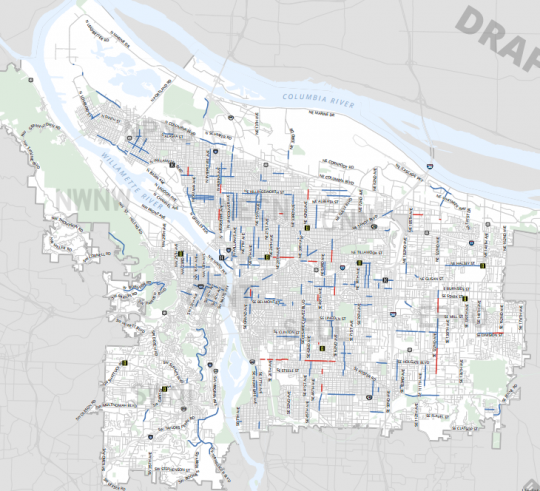
(Click the image to enlarge, or click here for a zoomable PDF)
A bit more than half of the money from the proposed tax (53 percent) would go to maintenance. And a large majority of that money (38 percent of total revenue) would go to repaving big streets.
As you can see from the map above, the vast majority of miles paved citywide in the first three years — the blue lines — would be “fog seal,” the quick cheap method embraced by the city in the last two years that reduces water seepage and other incremental damage to the pavement.
A smaller set of lane-miles, marked in red on the map, would get three to four inches of grinding and a full repaving job.
If you look at the PDF version of the map, you’ll see that, perhaps unsurprisingly, almost all the full repave projects would be on high-traffic streets such as SE 122nd Avenue, inner SE Holgate and NE Broadway in the 28th Avenue area. These are also, of course, the streets that are disintegrating the fastest because they get the most freight and bus traffic.
Meanwhile, some important bikeways (N Vancouver and Williams between Shaver and Killingsworth, for example, or SE Sandy Boulevard) would receive fog seal treatments in the first three years.
Advertisement
Safety projects
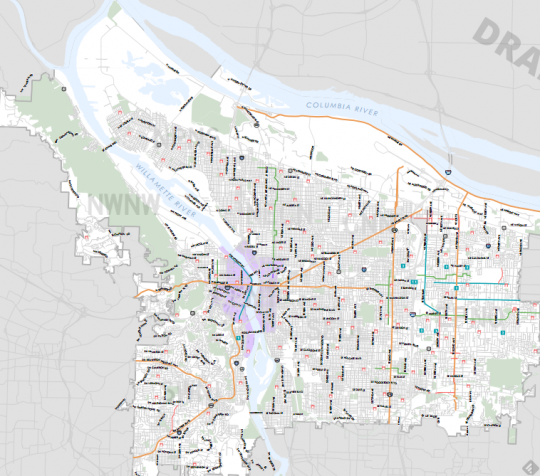
(Click the image to enlarge, or click here for a zoomable PDF)
One of the surprises on this map: a new neighborhood greenway on Northeast 9th Avenue north from the Lloyd District. Our Streets project manager Mark Lear said he understood that project was raised to become a high priority based on the high number of family-wage jobs it would help people connect to.
Another takeaway: though inner North and Northeast Broadway continues to be a focus of city plans for protected bike lanes, this plan envisions the project extending only to 24th Avenue in the first three years, rather than all the way to Cesar Chavez Bouelvard as envisioned by the Bicycle Transportation Alliance.
Safety projects and income
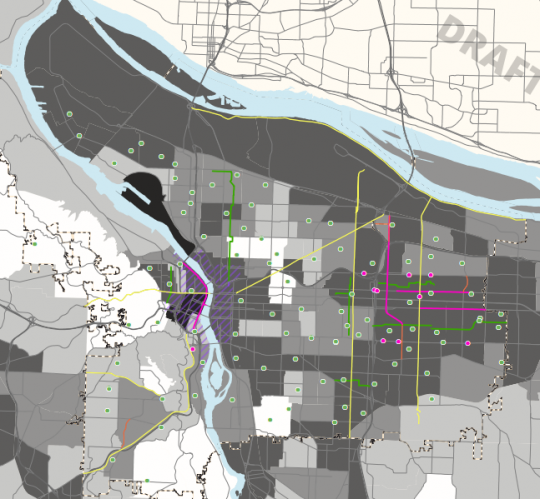
In general, the project list continues to show something that was obvious when we created our own map of the city’s working list: a huge share of the walking and biking improvements will land east of 82nd Avenue, neighborhoods that have Portland’s lowest median incomes.
Members of the East Portland Action Plan Bike Subcommittee, Lear said, “feel like this project is prioritizing East Portland safety improvements like nothing we’ve ever done before.”
Lear said that after the first three years, the city might have also done enough planning for protected bike lanes to be headed to East and Southwest Portland, too.
“What are those separated facilities that can really work on some of those bigger streets?” Lear said. “Hopefully in the 4 to 6 year time horizon we can get into more of that.”
Another major transportation improvement not shown on this map: a north-south frequent service bus line on 122nd Avenue, East Portland’s first.
Commissioner Steve Novick said Monday that this came out of a recent promise from TriMet General Manager Neil McFarlane.
“If we make $8 million of safety improvements along 122nd, they are confident that they can provide frequent service along that street,” Novick said.
Stay tuned for more coverage from Monday’s hearing on the proposed income tax, and see the city’s website for more details on how it’d spend the money.


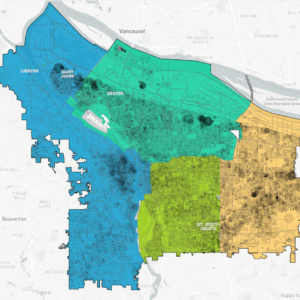

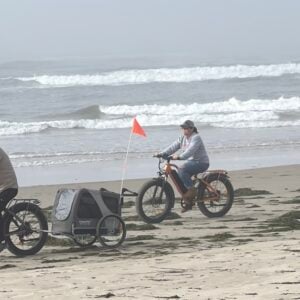
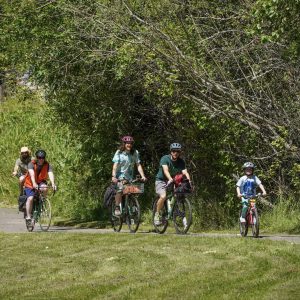
Thanks for reading.
BikePortland has served this community with independent community journalism since 2005. We rely on subscriptions from readers like you to survive. Your financial support is vital in keeping this valuable resource alive and well.
Please subscribe today to strengthen and expand our work.
It looks like the PDF link for the first two maps both go to the paving projects link. Could you put up the link to the PDF for safety improvements? Thanks!
Found it: http://www.portlandoregon.gov/transportation/article/506230
Thanks! Fixed.
So many roads in SW need an overhaul at least like what SW Maplewood Road got in 2013.
If inner SE Holgate gets a grind and repave, can they add in bike lanes at the same time, per the 2030 bike plan? It would connect well to the bike lanes coming to SE Foster.
Seriously! The mid-section (between 28th and 39th) could be a tight squeeze to get even normal-size bike lanes on, but the section between McLoughlin and 28th is begging for a road diet and buffered bike lanes.
Per the comments on here, it seems that the fog seal technique is problematic. Have there been any studies demonstrating how it affects traction? Especially bikes?
Always seemed soft and sticky to me, as the tar in the roads should be. I wonder if its a lack of bite from the exposed rock chips that are the surface of most roads. This should be most obvious with a harder tire or maybe offroad tires that rely mainly on tire blocks for the grip.
Then again, I think their newest thermoplastic on 52nd is worse than the stuff they put down a few years ago… but mostly on my shoes. The tires grip ok, putting a foot down was not as much fun.
If anyone does do studies, they should make sure to look at different tire compounds and shapes, and also bike shoes.
February 13th, 2014:
http://bikeportland.org/2014/02/13/pbot-director-says-new-action-plan-will-include-vision-zero-commitment-101441
“Here’s what Treat said on the subject last week…:
Vision Zero is something that I articulated to my staff within my first week of being here. one person being killed on our roads is too many. There’s no acceptable number of traffic fatalities. I think you have to say Vision Zero. And it’s definitely our philosophy as we’re approaching all of our transportation projects, is you start with the pedestrian and build from there. And in that manner you capture the safety aspects for all users of the roadway. We are working on selecting a consultant — it should be announced in the next week or two — to do our two-year action plan, and in that two-year action plan we will be outlining pedestrian safety goals and Vision Zero will be incorporated for certain. It’s identifying the steps of how we’re going to get there and it’s identifying the time frame. I’m committed to Vision Zero.”
(emphasis added by me)
Wow sounds like the city is pretty confident they are getting their money.
Frequent bus service up SE 122nd would be very desirable. We need more North-South bus service in East Portland. I ride the 71 up 122nd frequently in the winter months and sometimes the bike racks are full. More frequent bus service would help here.
Let TriMet know.
http://future.trimet.org
since they want to use most of this non-vehicle money on vehicle projects I guess I’ll be taking the lane on the big roads if this goes through… nobody can say I’m not paying my way…
they need to use the current money we pay to transportation on the ped/bike stuff and use only vehicle taxes/fees to pay for the motor vehicle damage mitigation stuff…
Those are my thoughts throughout all this…taking the lane is going to have to be the leverage to encourage the reversal of our inexorable slide to “city of meh” status